Growing up in our small neighborhood in Pilar, Bataan, the highlight of my afternoon was always the familiar call of "Buchi! Mainit-init pang buchi!" from Ate Leonie, who would walk down our street with her iconic blue basin filled with freshly-fried Buchi (sesame balls).
My siblings and I would rush out with our baon money, sometimes even borrowing a few pesos from each other, just to get our hands on these golden treasures.
I always love biting into that perfectly crispy sesame coating, feeling the chewy rice flour layer, and finally reaching the sweet red bean filling. It was pure childhood joy in every bite.
After years of kitchen experiments and learning, I've finally recreated Ate Leonie's buchi recipe, and today I'm sharing every secret technique I've discovered to help you make these beloved Filipino-Chinese treats in your own kitchen.
Jump to:
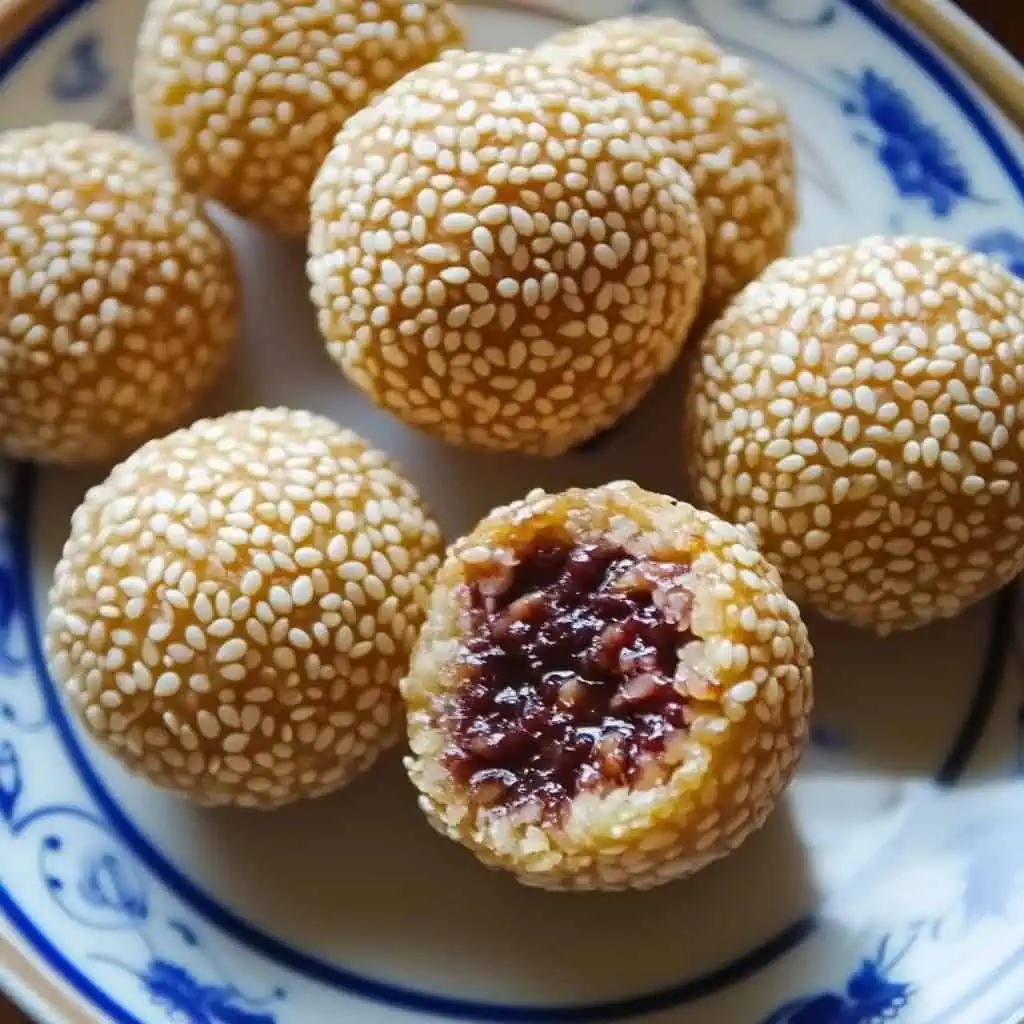
Why You'll Love This Recipe
- Perfectly balanced textures: crispy exterior, chewy middle, and creamy filling
- Make-ahead friendly - can be prepared in advance
- Customizable fillings to suit your taste
- Restaurant-quality results at home
- Great project for weekend baking
- Perfect for sharing at gatherings
- Cheaper than store-bought versions
Ingredients
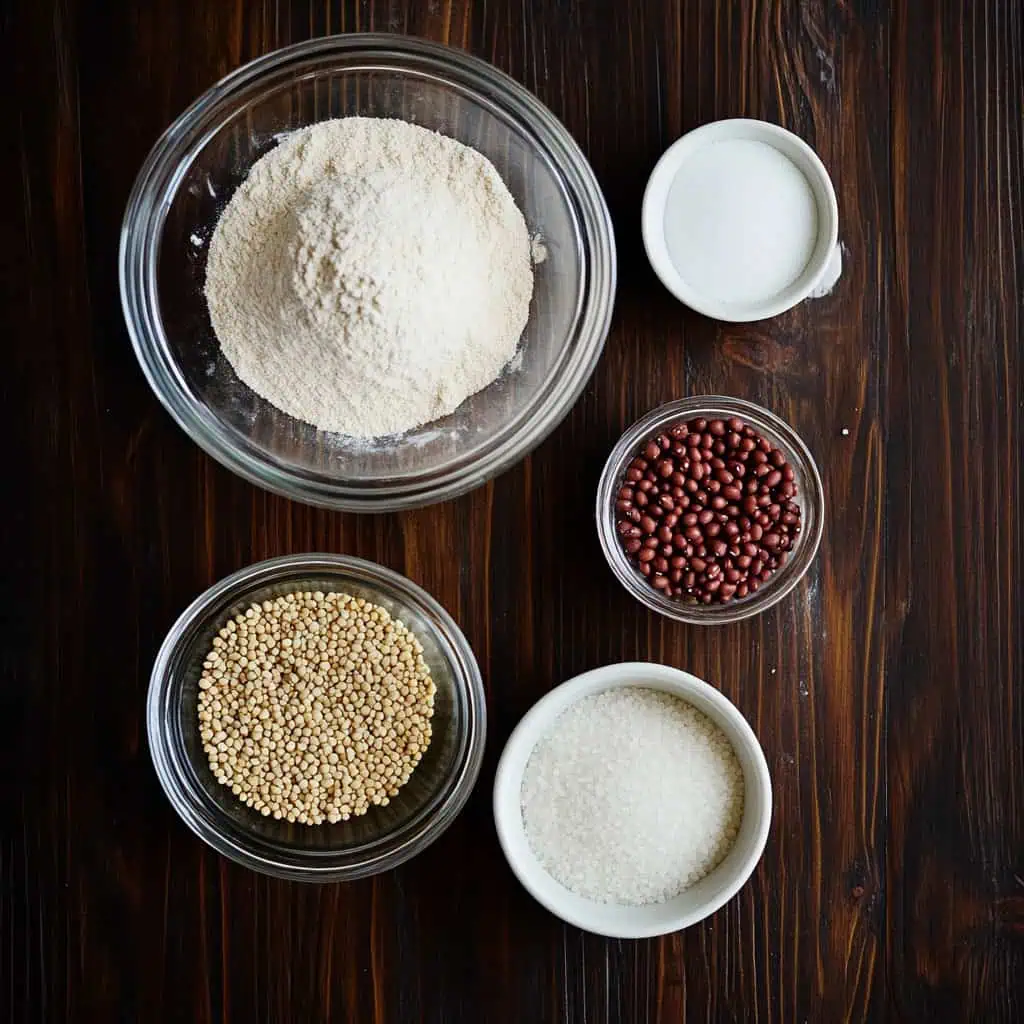
- 3 cups glutinous rice flour
- 1⅓ cups water
- ¾ cup sugar
- 1 cup sesame seeds
- 1 cup dried red beans (adzuki or peeled split mung beans)
- ½ cup sugar (for filling)
- Water for cooking beans
Equipment
- Heavy-bottom pot or wok - Provides even heat distribution for perfect frying
- Candy thermometer - Essential for monitoring oil temperature precisely to prevent bursting
- Kitchen scale - Ensures accurate measurements for consistent results
- Fine-mesh strainer - For washing sesame seeds and draining beans
- Spider strainer/slotted spoon - Makes removing buchi from hot oil easy and safe
- Food processor - Helpful for creating smooth bean paste
- Measuring cups and spoons - For accurate ingredient portioning
- Large mixing bowl - For comfortable dough preparation
- Plastic wrap - Prevents dough from drying while resting
- Baking sheet - Organizes uncooked buchi and helps workflow
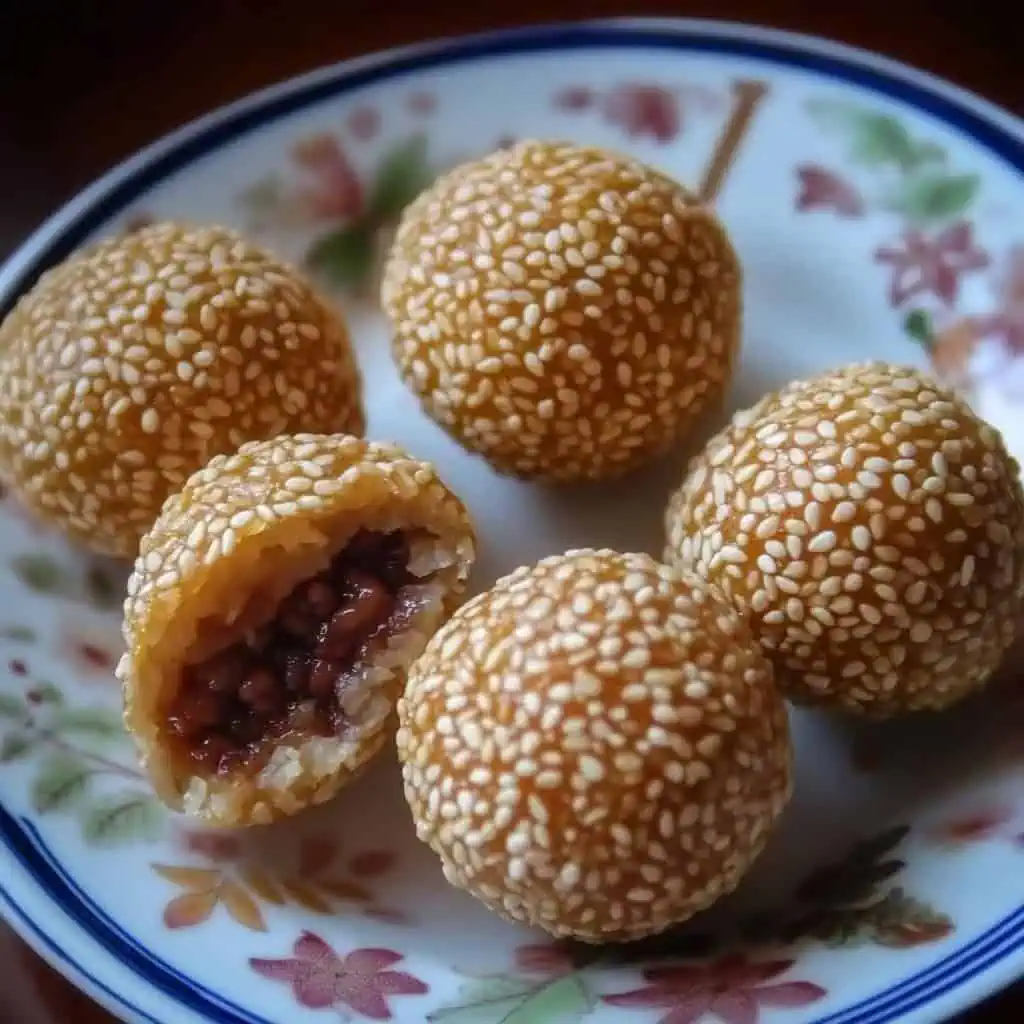
How To Make
- Prepare the filling: Soak red beans overnight or for at least 6 hours. Drain, rinse thoroughly, and cook in fresh water for about 1 hour until very tender. Process until smooth, mix with sugar, and cook down to a thick paste. Cool completely, then portion into small balls.
- Make the dough: Heat 1⅓ cups water with ¾ cup sugar until it reaches 180°F (82°C), stirring until sugar completely dissolves. Gradually pour this hot liquid into 3 cups glutinous rice flour, mixing as you go. Knead until smooth and pliable. Cover and rest for 20-30 minutes.
- Form the buchi: Divide dough into 24 equal pieces. Flatten each piece in your palm, place cooled bean filling in center, then carefully seal and roll into a smooth ball. Ensure there are no cracks or air pockets. Roll in sesame seeds, pressing gently for good adhesion.
- Fry to perfection: Heat oil to 320°F (160°C). Carefully drop sesame-coated balls into oil. The temperature will naturally drop to around 300°F (149°C). Fry while constantly turning for even cooking. Gradually increase heat to finish at 350°F (177°C). Buchi are done when they float and turn golden brown.
- Serve: Remove using a spider strainer and let cool slightly before serving. Best enjoyed warm.

Tips from Lola's Kitchen
- Hot water technique: Always use hot water for the dough - it partially "cooks" the flour, resulting in better texture
- Patience pays off: Never skip the dough resting time, as it allows the glutinous rice flour to fully hydrate
- Prevent drying: Keep dough covered with damp cloth when not in use
- Crack inspection: Check each ball for cracks before frying to prevent oil seepage
- Double-coat method: Roll in sesame seeds twice for better coverage
- Temperature control: Maintain proper oil temperature throughout frying (start 320°F, finish 350°F)
- Constant attention: Turn buchi continuously while frying for perfectly even cooking
- Test batch: Fry one buchi first to check temperature and timing before committing the whole batch
Substitutions
- Filling variations: While traditional red bean is classic, try these alternatives:
- Ube (purple yam) paste
- Peanut butter mixed with powdered sugar
- Chocolate ganache or Nutella
- Cream cheese sweetened with sugar
- Mung bean paste
- Sweetened coconut
- Flour: There is no substitute for glutinous rice flour (also called sweet rice flour) - it's essential for authentic texture
- Seeds: Use black sesame seeds for dramatic appearance or a mix of black and white for visual interest
- Sweetener: Coconut sugar can replace white sugar for a more caramelized flavor
Troubleshooting
Buchi Deflating?
- Ensure oil temperature is correct (too hot or too cold can cause collapse)
- Don't rush the cooking process - gradual temperature increase is key
- Check dough consistency - it should be smooth and pliable
- Avoid overworking the dough which can make it tough
Sesame Seeds Falling Off?
- Lightly moisten seeds with water before rolling
- Double-coat by rolling twice with a rest in between
- Press seeds firmly but gently into dough surface
- Ensure dough surface isn't too dry when rolling
Buchi Bursting During Frying?
- Always check for air pockets before frying (squeeze gently)
- Start at lower temperature (320°F) and increase gradually
- Don't overcrowd the frying pan - work in small batches
- Make sure filling is completely sealed inside
Storage & Reheating
- Room temperature: Enjoy within 1 day
- Refrigerator: Store in airtight container up to 3 days
- Freezer: Uncooked buchi can be frozen for up to 1 month (freeze on baking sheet first, then transfer to freezer bag)
- Reheating: For best texture, warm in 375°F (190°C) oven for 2-3 minutes
- Frying from frozen: You can fry frozen uncooked buchi without thawing, but watch temperature carefully
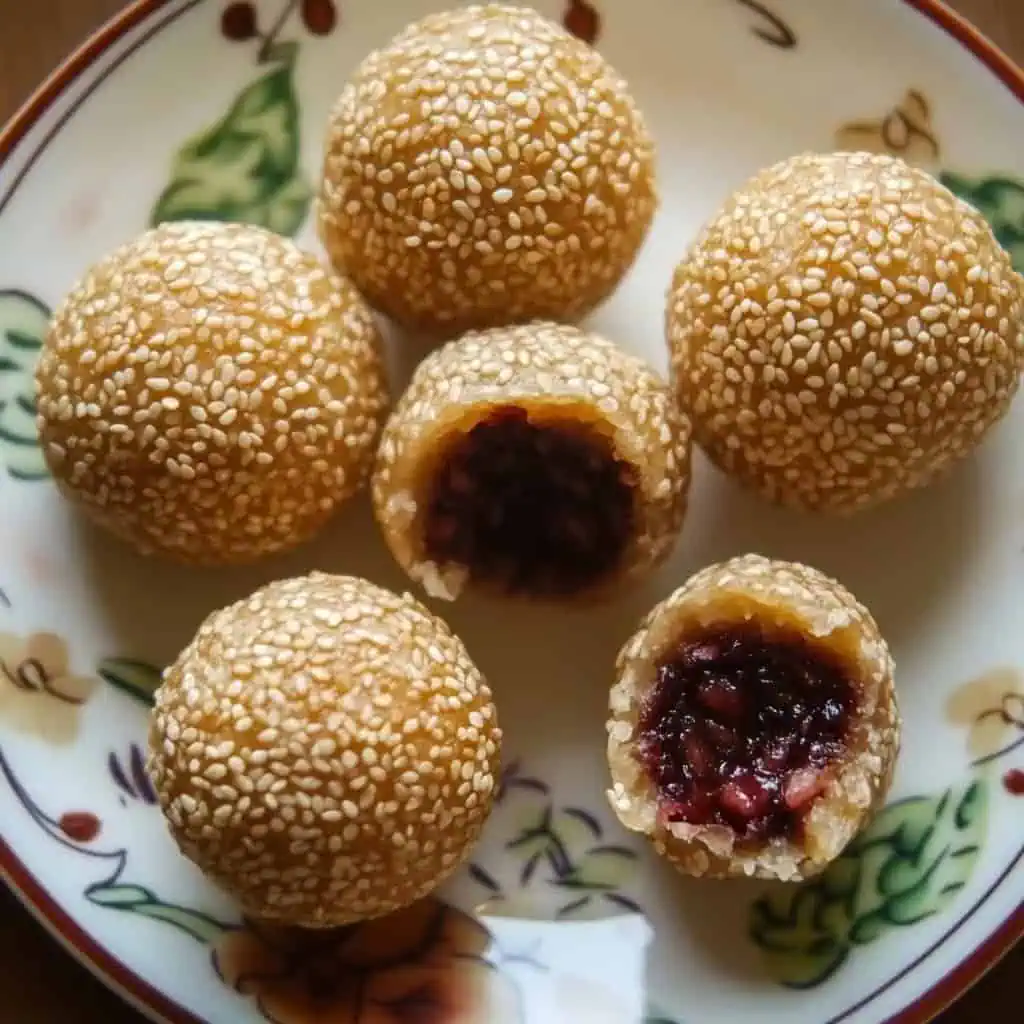
FAQ
Can I make the dough ahead of time?
Yes, you can prepare the dough up to 24 hours in advance. Keep it tightly wrapped in plastic in the refrigerator. Bring to room temperature before forming.
Why did my buchi deflate after cooking?
Deflating usually indicates incorrect oil temperature or improper flour. Use only glutinous rice flour and maintain steady oil temperature throughout cooking.
Can I use regular rice flour instead of glutinous rice flour?
No, regular rice flour will not produce the chewy texture that makes buchi special. Glutinous (sweet) rice flour is essential.
How do I know when buchi is fully cooked?
Properly cooked buchi will float to the surface of the oil and have a golden brown color. The cooking process typically takes 7-9 minutes total.
Can I air fry buchi?
Air frying is not recommended for authentic buchi. The traditional deep-frying method is essential for developing the characteristic texture and expansion.
How do I prevent oil splatter when frying?
Make sure all buchi are free of cracks, lower them into the oil gently using a spider strainer, and maintain proper oil temperature.
What's the best oil for frying buchi?
Use a neutral oil with high smoke point like vegetable, canola, or peanut oil.
Can I make mini versions?
Yes! Smaller buchi make great party bites. Reduce cooking time slightly and watch temperature carefully.
Related
Looking for other recipes like this? Try these:
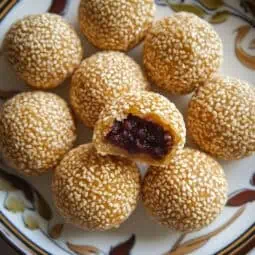
Buchi (Filipino Sesame Balls)
Equipment
- Heavy-bottom pot or wok (kawali) For deep frying; ensures even heat distribution
- Candy thermometer To monitor oil temperature accurately
- Kitchen scale (timbangan) For precise measurements
- Fine-mesh strainer (salaan) For washing sesame seeds
- Spider strainer/slotted spoon For removing buchi from hot oil
- Food processor Optional, for making bean paste (panghiwa ng pagkain)
- Measuring cups and spoons (Panukat) For accurate ingredients
- Large mixing bowl (mangkok na malaki) For dough preparation
- Plastic wrap To cover dough while resting
- Baking sheet For organizing uncooked buchi
Ingredients
For the Dough
- 3 cups glutinous rice flour galapong
- 1⅓ cups water
- ¾ cup sugar
- 1 cup sesame seeds linga
For Traditional Red Bean Filling
- 1 cup dried red beans adzuki or peeled split mung beans
- ½ cup sugar
- Water for cooking
Instructions
- Start by soaking the red beans overnight or for at least 6 hours in water (Ibabad ang beans sa tubig). After soaking, drain and rinse the beans thoroughly. Cook them in fresh water for about 1 hour or until very tender. Process the cooked beans until smooth (hanggang maging malambot), then mix with sugar and cook down until it becomes a thick paste. Let the paste cool completely, then portion it into small balls and set aside.
- Heat 1⅓ cups water with ¾ cup sugar until it reaches 180°F (82°C), stirring until the sugar completely dissolves. Gradually pour this hot liquid mixture into 3 cups of glutinous rice flour, mixing as you go. Knead the mixture until it becomes a smooth, pliable dough (masahan hanggang lumambot). Cover the dough and let it rest for 20-30 minutes.
- After resting, divide the dough into 24 equal pieces. Take each piece and flatten it in your palm, place a portion of the cooled bean filling in the center, then carefully seal and roll into a smooth ball. Make sure there are no cracks or air pockets in the dough. Roll each sealed ball in sesame seeds (linga), pressing gently to ensure the seeds adhere well.
- Heat oil in a heavy-bottom pot or wok (kawali) to 320°F (160°C). Carefully drop the sesame-coated balls into the oil. The temperature will naturally drop to around 300°F (149°C) - this is normal. Fry the buchi while constantly turning them for even cooking. As they cook, gradually increase the heat to finish at 350°F (177°C). The buchi are done when they float to the surface and turn golden brown.
- Remove the cooked buchi using a spider strainer or slotted spoon and let them cool slightly before serving. They are best enjoyed hot or warm as merienda (afternoon snack). Any leftover buchi can be stored at room temperature for 1 day, in the refrigerator for up to 3 days, or frozen uncooked for up to 1 month. To reheat, place in a 375°F (190°C) oven for 2-3 minutes.
Tips from Lola's Kitchen
- Use hot water for the dough - it "cooks" the flour slightly
- Never skip the dough resting time
- Keep dough covered to prevent drying
- Check for cracks before frying
- Roll in sesame seeds twice for better coating
- Maintain proper oil temperature to prevent bursting
- Turn constantly while frying for even cooking
Nutrition
The Story Behind Buchi (Filipino Sesame Balls)
Growing up in the bustling streets of Binondo, Manila's historic Chinatown, I discovered that buchi (butsi) is more than just a sweet treat - it's a delicious testament to the centuries-old friendship between Filipino and Chinese cultures. This beloved sesame-coated rice ball, known in China as jian dui (煎堆), made its way to Philippine shores through early Chinese merchants and has since become an irreplaceable part of Filipino merienda culture.
While Chinese jian dui often features lotus paste filling, Filipino buchi adapted to local tastes by incorporating native ingredients like mung beans (monggo) and purple yam (ube). This fusion perfectly represents how Filipino cuisine embraces and transforms foreign influences into something uniquely its own. Walk through any Filipino market or commercial district today, and you'll hear vendors calling out "Buchi! Mainit-init pa!" (Hot and fresh buchi!), a sound that has become synonymous with afternoon snack time.
What makes Filipino buchi special is its perfect balance of textures - the satisfying crunch of toasted sesame seeds, the delightfully chewy glutinous rice layer, and that moment when you reach the sweet, creamy filling. Unlike its Chinese cousin, our local version tends to be slightly smaller and less sweet, making it the perfect companion to a hot cup of afternoon coffee or tea.
In many Filipino households, including mine, buchi holds a special place during celebrations and family gatherings. It's one of those rare treats that bridges generations - from grandparents who remember buying it for just a few centavos, to young children experiencing their first taste of this timeless delicacy. Today, while you can find buchi in many Asian bakeries and restaurants, nothing quite compares to the satisfaction of making it at home, following time-tested techniques passed down through generations.
Did you know? The round shape of buchi symbolizes unity and completeness in Chinese tradition, making it a popular treat during Lunar New Year celebrations in both Chinese and Filipino-Chinese communities.
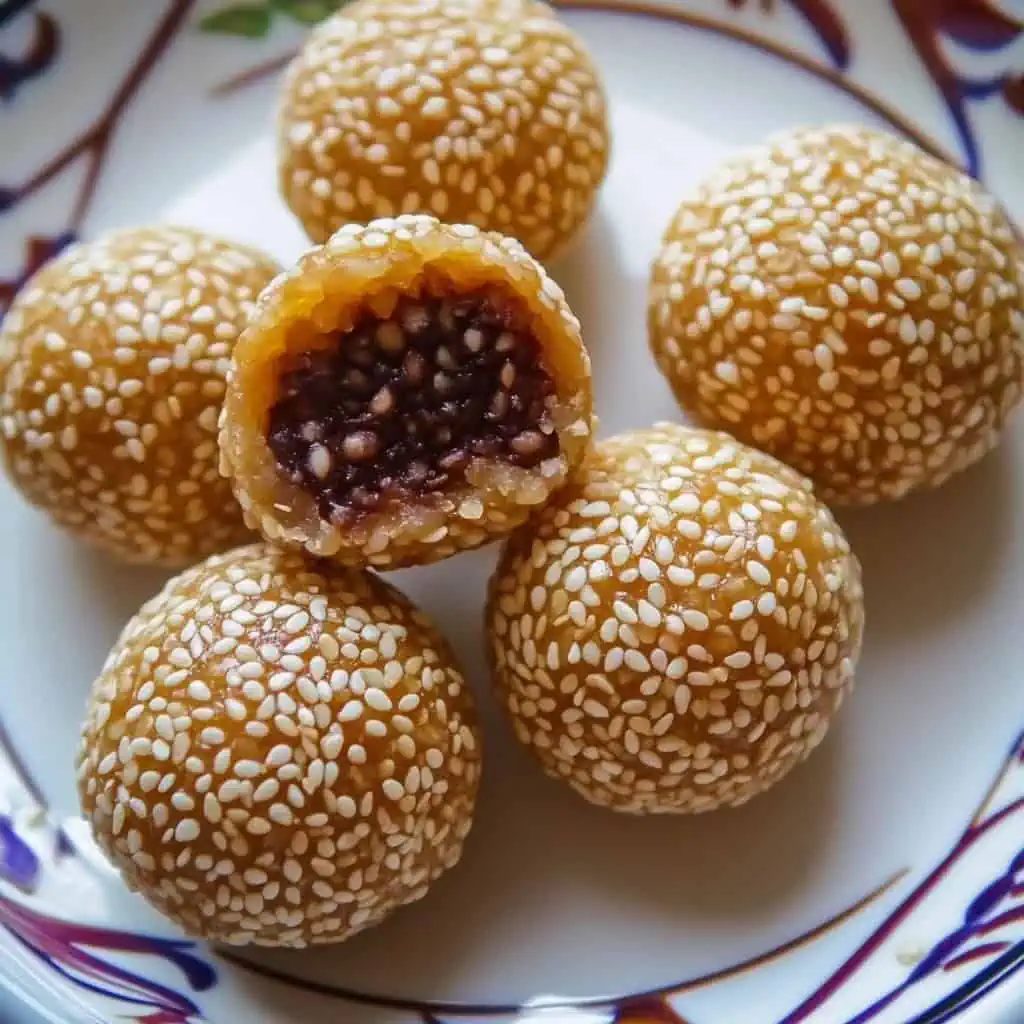






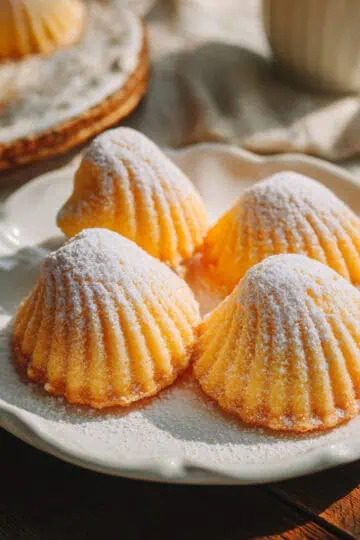
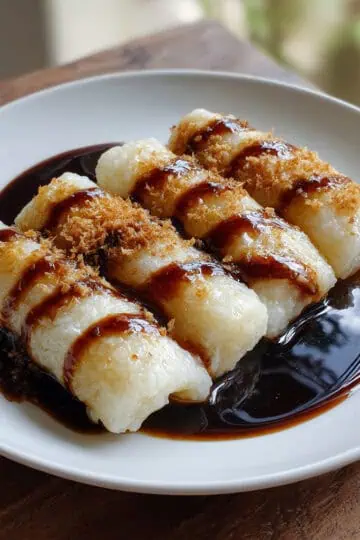

Comments
No Comments